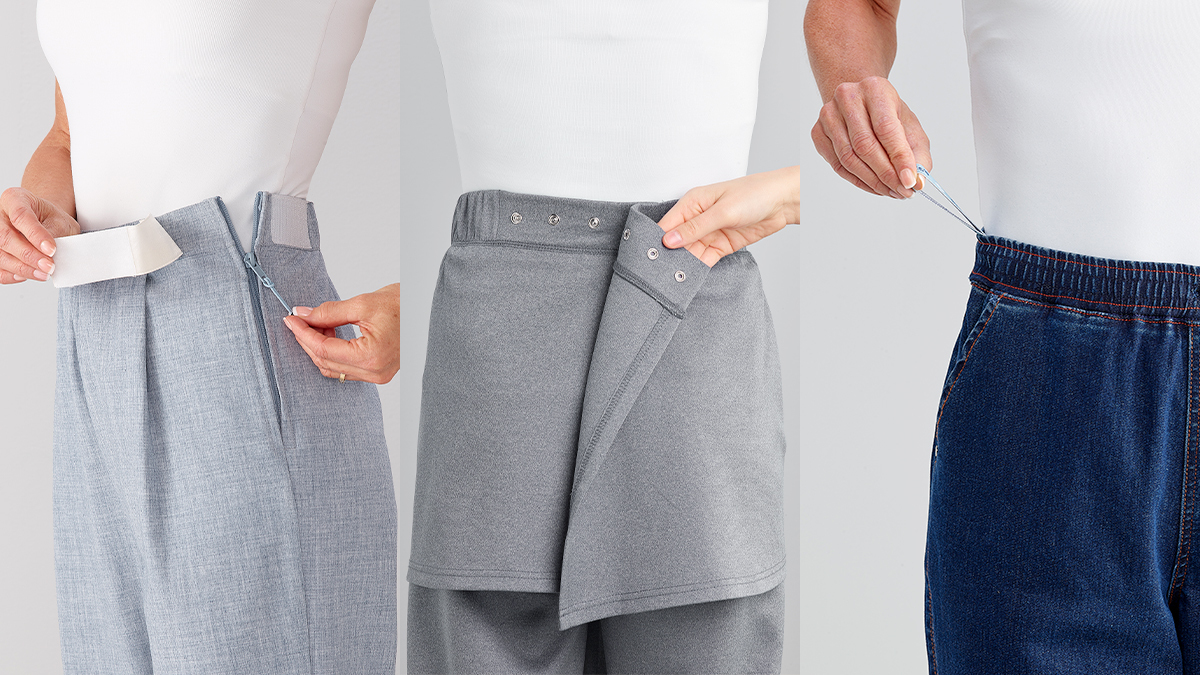Post-Hip Surgery Must-Haves to Help Recovery
Post-surgery recovery is an essential time to focus on your health to help ensure the best possible outcome. While recovery varies with each person, the general hip surgery population does fairly well three months post-op.
Medical professionals will remind you about the importance of physical therapy for rehabilitation exercises to avoid blood clots and reduce swelling or pain. Occupational therapy interventions are also essential to help you navigate your daily activities and routines more safely post-surgery.
In addition to these, there are also post-hip surgery must-haves (like adaptive clothing!) we explore below. Help set yourself or a loved one up for success before heading into surgery by following this guide.
What is Needed at Home After Hip Replacement Surgery?
When returning home after hip replacement surgery, be sure your living space is set up to support your recovery. This organization can be done beforehand to lessen the stress post-surgery or afterward with the help of an occupational therapist.
Implementing certain aids, such as adaptive equipment options, can help create a safer and more stabilized home environment that can help recovery progress.
Priority rooms often include: the bedroom, bathroom and kitchen — or wherever the most time is usually spent.
Walking is essential to speed recovery. Be sure to have a comfortable walker for you or your loved one to help support and stabilize moving independently in the first weeks or months after surgery.
As strength and stability are gained during recovery time, you may be ready to transition to a cane or crutches. Always remember to check with your medical care team.
In the bathroom, installing grab bars around the toilet and shower or tub can provide added support and safety. These adaptive aids also increase independence. It’s also helpful to install a tub or shower chair to let you rest while bathing. Another useful adaptive device is a raised toilet seat to provide as much comfort and ease as possible.
Adaptive clothing and post-surgical clothing are also essential during the recovery period. These garments are designed to reduce hip pain and increase ease and comfort when dressing.
5 Post-Hip Surgery Must-Haves
Recovering from hip surgery can be a challenging journey, but having the right items on hand can significantly ease the process. Here are five essential must-haves that will support your healing and enhance your comfort during the crucial post-surgery period.
Zipper Closure Recovery Tops
Zipper closure tops are a fantastic clothing choice during recovery after hip surgery. Silverts easy-grip zipper tops have extended pull tabs, making it easy to dress yourself with little effort.
The specially crafted post-surgery recovery tops are designed with access points for post-surgery exams and recovery. These tops appear to be trendy conventional tops but give you freedom and comfort with this added functionality.
Front-zip tops are another great option during rehabilitation since they allow a medical professional to quickly assess you or provide necessary medications or exams while allowing the hip replacement patient to remain dressed.
Side Zip Pants
Side zip pants open a new realm of possibilities during post-surgical recovery time.
Someone needing assistance with dressing, such as after a partial or total hip replacement, could be helped with little effort when pants have zippers on each leg. They also allow for easier medical intervention and assessment, allowing you to remain dressed during a post-op checkup.
These adaptive side-zipper pants are also designed for comfort (which is so helpful post-surgery) and are easy for self-dressing or assisted-dressing.
Adaptive Nightgowns
Nighttime wear, such as nightgowns and other sleepwear, should also be included in your post-surgical wear package.
Silverts has created adaptive nightgowns specifically for post-surgical recovery. These specially designed sleepwear options help the hip replacement patient to be dressed easily with as little discomfort as possible.
Whether you are in hospital or at home, adaptive sleepwear with easy access closures help ensure you or a caregiver can quickly help with middle of the night toileting or treatment.
Closures on post-surgery adaptive sleepwear are designed to avoid pressure points and provide comfort so you can sleep well all night long, which is essential during recovery.
Supportive Footwear
During recovery from a partial or total hip replacement surgery, it’s important to focus on stabilizing footwear that will provide proper support and reduce falls.
When looking for appropriate post-hip surgery footwear, find styles that are easy to take on and off with ease, such as Silverts extra wide comfort shoes that have wide openings and adjustable closures to create the perfect fit.
Supportive footwear should also have rubber soles to help reduce slips and falls. Extended heels also offer additional stabilities with each step taken.
Walkers and Crutches for Mobility Support
Set yourself up for success after hip surgery. Enhance your recovery and reduce rehabilitation time by speaking with your medical care team being discharged from hospital. These medical professionals can help you select the mobility aids that will be most helpful for your recovery.
Your physical therapist and occupational therapist will also be able to suggest adaptive equipment to help you through your recovery period at home.
Using a walker after hip-replacement surgery is often advised. Whether you choose a rollator or one with skids, walkers can provide enhanced stability.
As you build back strength and stability during recovery, your medical team will advise you when it’s safe to use crutches instead of a walker.
How Long Does Hip Recovery Take?
Recovery from hip replacement surgery can vary significantly based on individual health factors and the specifics of the surgery, but generally follows a structured timeline. Typically, patients may start to walk with assistance within days and can expect to return to light activities within 2-4 weeks [1]. Pain management and physical therapy are crucial during the first few weeks.
A more complete recovery, including the ability to engage in more strenuous activities, may take up to six months or longer, depending on the patient’s progress and adherence to rehabilitation protocols. Remember to follow the advice of medical professionals during your recovery time.
For specific recommendations on clothing to wear after pacemaker surgery and the best clothes to wear after back surgery, visit Silverts’ latest post-surgery recovery wear.
Sources
Thakkar, Savyasachi. John Hopkins Medicine. Hip Replacement Recovery: Q&A with a Hip Specialist. https://www.hopkinsmedicine.org/health/treatment-tests-and-therapies/hip-replacement-recovery-qa. Accessed on June 13, 2024





No Comments